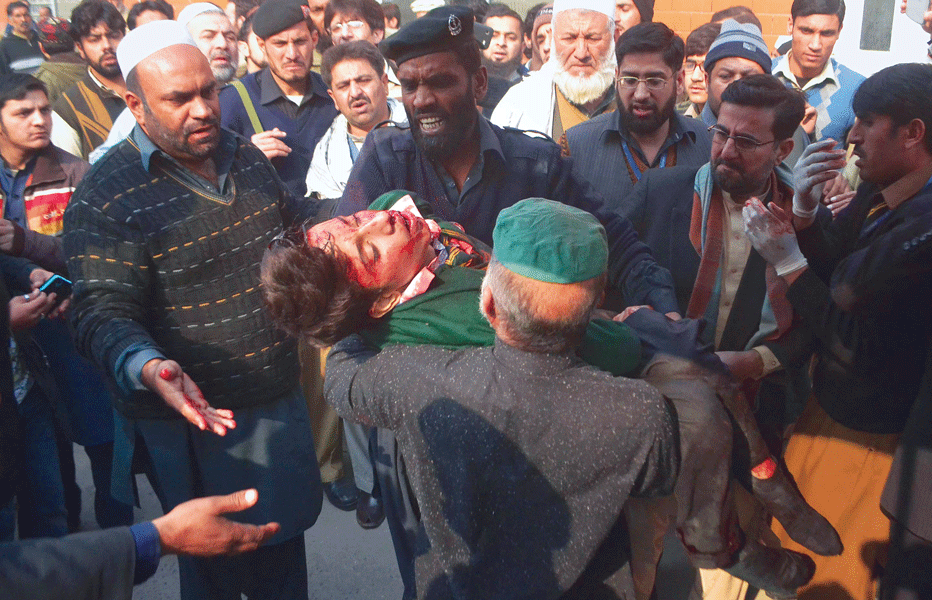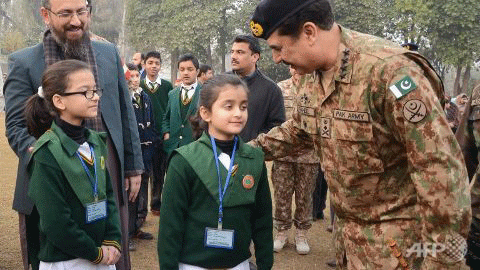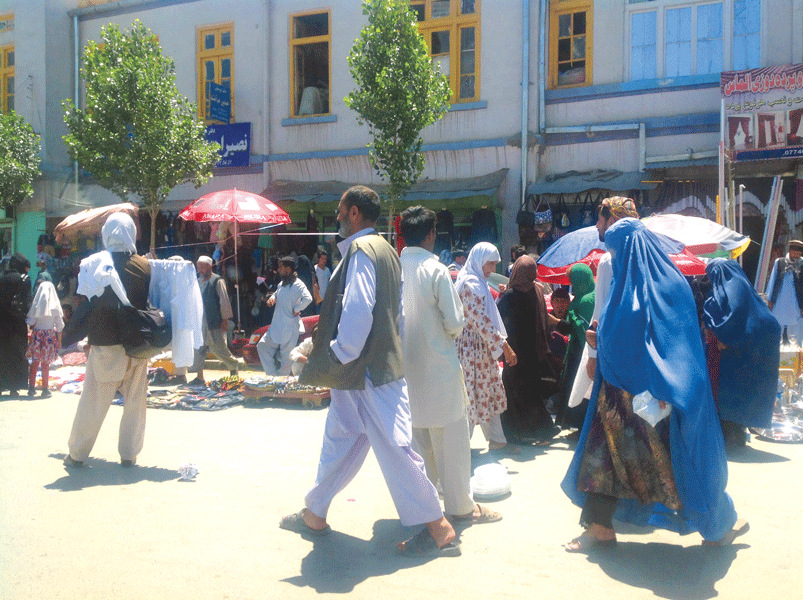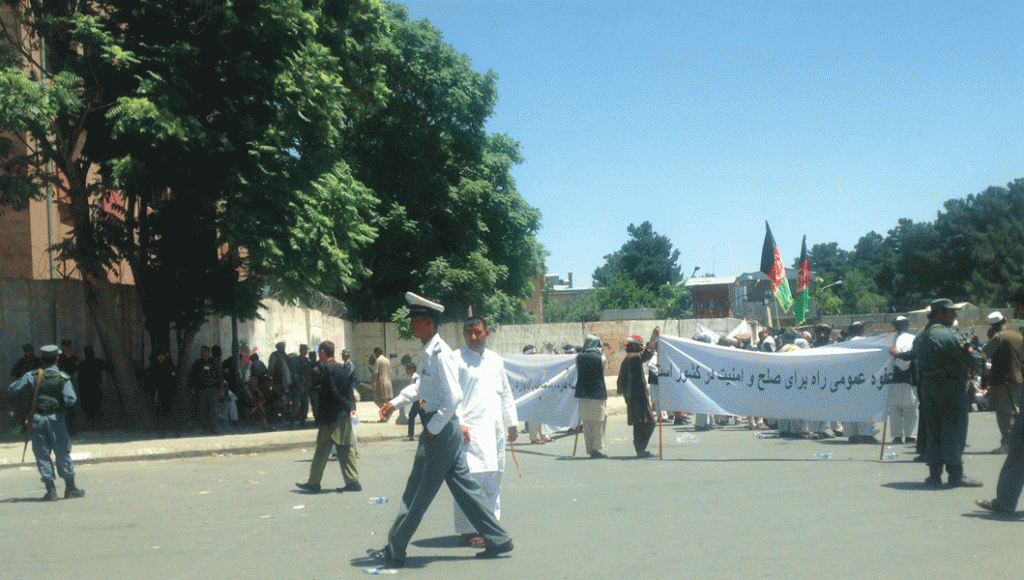Indo-Pak peace in the Peshawar aftermath With the Peshawar attack, a new opportunity opens up in the troubled quest for conflict resolution and peace between India and Pakistan.
As the shock of the horrific massacre of innocent school children in Peshawar sinks in, the world and in particular Pakistan’s neighbours may well need to revise their assessment on where Pakistan will be a year from now. Prime Minister Nawaz Sharif referred to the murderous assault by the Taliban as ‘blow-back’ reaction to the army’s continuing operations in North Waziristan, which has lead to substantial civilian collateral damage and mass displacement. This reaction, while correct, is incomplete. But there is only so much a Pakistani politician can say about the army, which is rightly referred to as the establishment.

The Peshawar attack is only a continuation of the increased violence targeted at innocent civilians that the AfPak region has seen in the recent past. In December 2014 a Taliban suicide attack killed around 80 spectators at a volleyball match in the Afghan province of Paktika, just across the North Waziristan border. Since the re-emergence of the Taliban in 2005, there used to be a winter lull in the fighting. This year, for the first time, the security situation all over Afghanistan, particularly in Kabul, continues to deteriorate. Suicide and other attacks have actually gone up, focused on soft targets. This might have caught the new Afghan government and its international supporters unawares, but not dispassionate observers.
Afghanistan blues
For most of the year, the Afghan people were involved with the presidential election that relegated the insurgency, insecurity and public corruption to the backseat. It did seem that the country had turned the corner. The election exercise, in which Dr Abdullah, former foreign minister who contested against Ahmed Karzai in 2009, was pitted against Ashraf Ghani, a former finance minister and ex-World Bank employee, was tumultuous. US Secretary of State John Kerry had to fly into Kabul twice and persuade both contestants to come to a power-sharing agreement. Dr Ghani became the president and appointed Dr Abdullah as the chief executive.
Critical to future of Afghanistan, the new president signed the bilateral security agreement with the US for continued presence of US troops in the country beyond 2014, to support the Afghanistan national security forces to tackle the raging insurgency.

Yet three months down the line, the situation in Afghanistan has deteriorated beyond most expectations. The major reason is the Pakistan army’s need for instability in Afghanistan to ensure its continued dominance over Pakistan’s strategic sphere, including a disproportionate share of national resources. Unfortunately, this dominance comes at a price, paid primarily by the people of India, Pakistan and Afghanistan. A short historical detour explains this dynamic.
Jinnah and Pakistan
The noted Pakistani-American historian Ayesha Jalal has argued that for Jinnah, the demand for Pakistan was a bargaining chip and that neither he nor the Muslim League leadership had actually prepared for it. The campaign for Pakistan was long on imagery but short on detail. The rapid and mass transfer of population led to Pakistan facing a paucity of professional and commercial talent. Further, the general upheaval and anarchy prompted fears of a collapse of the new State, which faced a strong internal challenge on the language issue. The Pakistani leadership resorted to the classic stratagem of diversion. The result was a State-sponsored ‘tribal’ invasion of Kashmir. The concept of proxy war was born, and continues to guide the actions of the Pakistan army till the present.
Weak State, strong Army
The weakness of the Pakistani political establishment that lacked a mass base, unlike the Congress party in India, meant that it had to co-opt the bureaucracy and the armed forces into the ruling arrangement. With its ability to remove governments, the army became the establishment that ruled either directly, through political proxies or by severely constraining the civilian government’s space for autonomous action; the exception being Bhutto’s 5 years when the army, smarting from its defeat in Bangladesh, was forced on the back foot. But not for long. Eventually the army struck and took control, which Bhutto’s megalomania, incompetence and growing authoritarianism enabled.
Coming to Pakistan-Afghanistan relations, Pakistan’s discomfort with Afghanistan goes back to 1947 when the latter voted against the former’s admission to the United Nations on the grounds that the lands ceded by it ‘temporarily’ to British India in 1893 should revert to Afghanistan once the Raj ceased to exist. The entire Khyber Pakhtunkhwa province, the federally administered tribal areas and north Baluchistan including Quetta, was Afghan territory ceded to British India for a hundred years in terms of the Treaty of Gandamak. This has been a sore point between the two countries, made acute by the presence of Pashtun tribes of the AfPak region who have never seen the ‘border’ as an impediment to continued close social, economic and political relations.

The collapse of the Najibullah regime due to withdrawal of Russian supplies in 1992, the failure of Afghan jihadis to form a stable government and their strong independent streak, reflected in their refusal to toe the Pakistani line, meant that the latter had to invent a role for themselves in a country whose fate they thought they controlled by virtue of hosting and channeling support for the Afghan jihadis for a decade. But the jihadi government formed in Kabul opened lines of engagement with India, reflecting Afghan unease with Pakistan. Pakistan Army Chief Aslam Beg consequently devised the theory of Afghanistan providing Pakistan with strategic depth in a potential war with India. Subsequently, the Pakistani army seemed to achieve its strategic pinnacle when its murderous proxies became the defacto rulers of most of Afghanistan. Their subsequent toppling following 9/11 and the installation of a plural, democratic regime in Afghanistan saw the reputation of the Pakistani army at its lowest ebb.
India emerges reliable partner
In this period India emerged as a reliable partner, politically and in terms of development assistance. All surveys of Afghan public opinion for the past decade show India as the most admired country, and Pakistan as the least trusted. Despite this, Pakistan emerged as the key arbiter since the re-emergence of Taliban as a formidable insurgency. While Pakistani army’s exact role in this can be debated, the presence of Osama bin Laden on Pakistani soil, and the safe havens available to the Taliban in Pakistan, allowing them to regroup, train and launch cross-border attacks, the detention and sometimes liquidation by the Pakistani army of any Taliban leader attempting direct approaches to Kabul, is incontrovertible evidence that the road to peace runs through Rawalpindi. And suggests that Afghanistan is the site of a supposedly proxy war between India and Pakistan. But this is to ignore empirical evidence and fall for myths spread to justify Pakistani involvement in internal Afghan matters.
The real reason lies elsewhere. Realising India’s size and strength, it was obvious that a conventional war would leave the Pakistani army with a bloodied nose. Hence the concept of proxy war was refined to an asymmetrical war; first the Sikh militants were given support but when the Khalistan movement failed, insurgency in Jammu & Kashmir was encouraged. When the local jihadis dried up, supply from Pakistan and the territories under its control kept insurgency and terrorism alive in Kashmir at great cost to the locals.
But while spawning India-focused jihadi outfits like Lashkar-e-Tayyaba, Jaish-e-Mohammed, and reviving the Taliban, and the Haqqani network, to take on the democratic regime in Afghanistan and its supporting international coalition, the Pakistan Army’s policy seems to have run out of control with many jihadis evolving their own agendas. The failure of the Pakistani state to deliver on inclusiveness, on participation has triggered huge fault lines in the Pakistani society. So while secular Pashtun nationalism does not challenge the State any more, the persecution of Ahmadiyas, Shias and minorities as well as the presence of a large, ill-educated and unemployable youth portends ill for the future. Added to these is the demonisation of the US and India. The result is the creation of an atmosphere of helplessness and victimhood that is an impediment to social cohesion and economic growth.
Even three months after the elections, the situation in Afghanistan has deteriorated beyond most expectations.
After the success of the Islamic State (IS) in Syria and Iraq, Peshawar and now Paris, the world seems poised on a razor’s edge. Can the jihadis who now seem empowered to strike at will be contained? Or are we in for worse times? Closer home and relevant to this article, do both India and Afghanistan, along with the increasingly vocal civil society of Pakistan, have a similar stake in peace and good neighbourly relations? Is there a link between peace in the subcontinent and in larger world?
Bhutto and Vajpayee fail
It must be understood that the road ahead is uncertain and dangerous. The creation of Bangladesh and the humiliating defeat of the Pakistani army exposed the hollowness of the two-nation theory. Yet, even in such propitious circumstances, sustainable peace was elusive. Bhutto sought time at Shimla to ‘ready’ his country into accepting the Line of Control in Kashmir as the border. This never happened as Bhutto too adopted an anti-India line increasingly. The next big opportunity was Lahore in 1999 when both Vajpayee and Nawaz Sharif were determined to put the past behind them, and create a constituency for peace based on deep economic relations. They banked on the presence of nuclear arms on both sides acting as a deterrent to military options. The Pakistan army sabotaged this by its Kargil misadventure.
So should one be pessimistic about the chances for peace given past record and the corporate interests of the Pakistan army? The answer, surprisingly, is not an unequivocal ‘no.’
The question then is what has changed? For one, for some time now, the Pakistan army has been trying to change its internal doctrine to say that it is not India but internal jihadi Islam that poses the biggest challenge to the nation. The distinction between a ‘good’ terrorist who targets India, Afghanistan and the US army, and the ‘bad’ terrorists who targets the Pakistani army was becoming increasingly hollow. Despite this, till the Peshawar killings, all Pakistani army operations including in North Waziristan had targeted the ‘bad’ terrorists and allowed the ‘good’ terrorists safe passage and sanctuary. However most of the ‘bad’ terrorists were also the creation of the Pakistan army. So this issue had to be addressed.

China’s moderating influence cannot be ruled out. China faces a minor jihadi threat from extremists in Xinjiang but which can be scaled up. Worse, a collapsing Pakistani State would be a dilemma for China. Furthermore, China would like to see a peaceful Afghanistan, irrespective of the composition of its government, so as to access its huge mineral deposits. And it fears contagion into Central Asia, and Xinjiang, from a failed Afghanistan.
The Pakistan army’s resolute anti-terrorist actions since Peshawar, if sustained, can be a game changer. However there are committed Islamists within the army for whom the jihadi agenda trumps all else. They would not be happy with this change in army policy and would go to any lengths to sabotage it. Earlier there have been assassination attempts on Musharraf, attacks on army headquarters, on naval and air stations and targeted killings of senior army officers. They would try to create tensions with India that would divert the army away from its anti-terrorists campaigns. It is these forces that have upped the ante in Afghanistan to frighten local players into accepting the former’s superior position. They realise that if jihadism fails in Pakistan, it would fail in Afghanistan, and lead to a reappraisal of the Indian ‘threat’ in Pakistan. The Pakistani civil society is already pushing this agenda but cannot succeed on its own.
Will the committed Islamists within the Pakistani army allow its anti-terrorism
drive to succeed?
Globally, till the rise of the IS, Pakistan figured in almost all terror attacks in the world by being the place where the terrorists had been indoctrinated and trained. The Afghan jihad provided the crucible that tested the terrorist mode of ‘inflicting a thousand cuts’ on its enemies. Its defeat in Pakistan could be the body blow that would reduce terrorism into becoming local nuisance. Clearly a lot is at stake and the world in general, and the subcontinent in particular, must help bring about this transformation.
(The author, a retired IAS officer is Director,
South Asian Institute for Strategic Affairs
and an expert on Pakistan and Afghanistan.)
